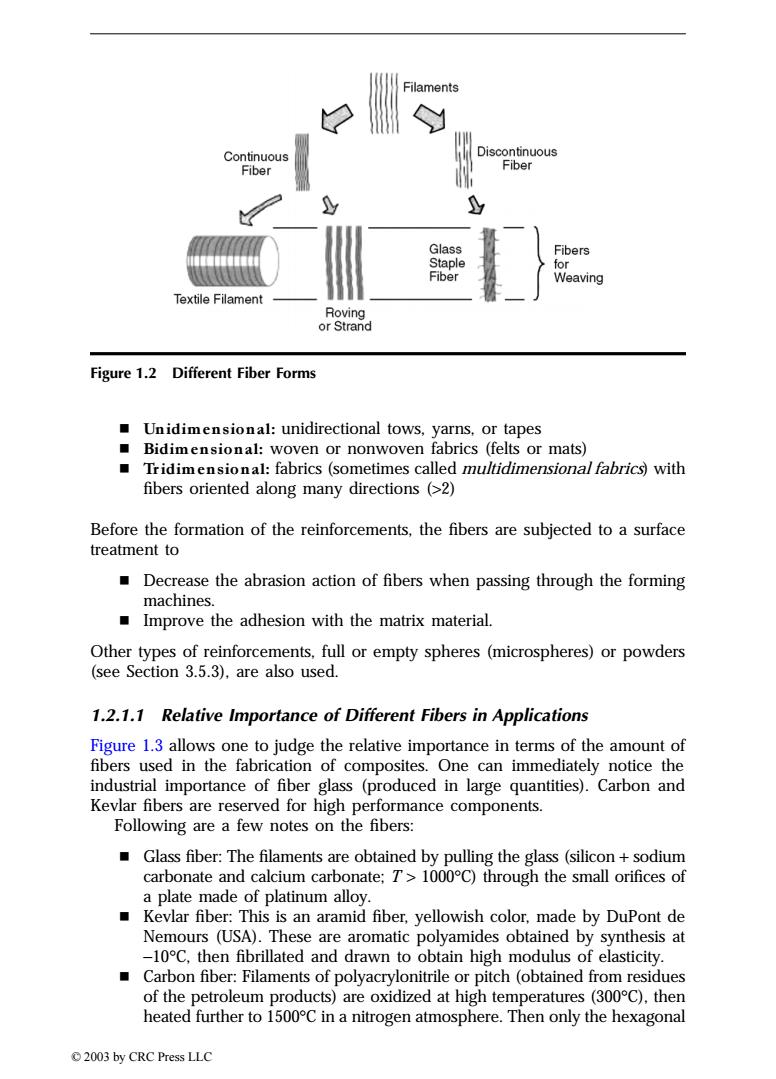正在加载图片...

Filaments Continuous Discontinuous Fiber Fiber Glass Fibers Staple for Fiber Weaving Textile Filament Roving or Strand Figure 1.2 Different Fiber Forms Unidimensional:unidirectional tows,yarns,or tapes ■ Bidimensional:woven or nonwoven fabrics (felts or mats) Tridimensional:fabrics (sometimes called multidimensional fabrics)with fibers oriented along many directions (>2) Before the formation of the reinforcements,the fibers are subjected to a surface treatment to Decrease the abrasion action of fibers when passing through the forming machines. Improve the adhesion with the matrix material. Other types of reinforcements,full or empty spheres(microspheres)or powders (see Section 3.5.3),are also used. 1.2.1.1 Relative Importance of Different Fibers in Applications Figure 1.3 allows one to judge the relative importance in terms of the amount of fibers used in the fabrication of composites.One can immediately notice the industrial importance of fiber glass (produced in large quantities).Carbon and Kevlar fibers are reserved for high performance components. Following are a few notes on the fibers: Glass fiber:The filaments are obtained by pulling the glass(silicon+sodium carbonate and calcium carbonate:T>1000C)through the small orifices of a plate made of platinum alloy. Kevlar fiber:This is an aramid fiber,yellowish color,made by DuPont de Nemours (USA).These are aromatic polyamides obtained by synthesis at -10C,then fibrillated and drawn to obtain high modulus of elasticity. Carbon fiber:Filaments of polyacrylonitrile or pitch(obtained from residues of the petroleum products)are oxidized at high temperatures(300C).then heated further to 1500C in a nitrogen atmosphere.Then only the hexagonal 2003 by CRC Press LLC Unidimensional: unidirectional tows, yarns, or tapes Bidimensional: woven or nonwoven fabrics (felts or mats) Tridimensional: fabrics (sometimes called multidimensional fabrics) with fibers oriented along many directions (>2) Before the formation of the reinforcements, the fibers are subjected to a surface treatment to Decrease the abrasion action of fibers when passing through the forming machines. Improve the adhesion with the matrix material. Other types of reinforcements, full or empty spheres (microspheres) or powders (see Section 3.5.3), are also used. 1.2.1.1 Relative Importance of Different Fibers in Applications Figure 1.3 allows one to judge the relative importance in terms of the amount of fibers used in the fabrication of composites. One can immediately notice the industrial importance of fiber glass (produced in large quantities). Carbon and Kevlar fibers are reserved for high performance components. Following are a few notes on the fibers: Glass fiber: The filaments are obtained by pulling the glass (silicon + sodium carbonate and calcium carbonate; T > 1000∞C) through the small orifices of a plate made of platinum alloy. Kevlar fiber: This is an aramid fiber, yellowish color, made by DuPont de Nemours (USA). These are aromatic polyamides obtained by synthesis at -10∞C, then fibrillated and drawn to obtain high modulus of elasticity. Carbon fiber: Filaments of polyacrylonitrile or pitch (obtained from residues of the petroleum products) are oxidized at high temperatures (300∞C), then heated further to 1500∞C in a nitrogen atmosphere. Then only the hexagonal Figure 1.2 Different Fiber Forms TX846_Frame_C01 Page 5 Monday, November 18, 2002 10:34 AM © 2003 by CRC Press LLC